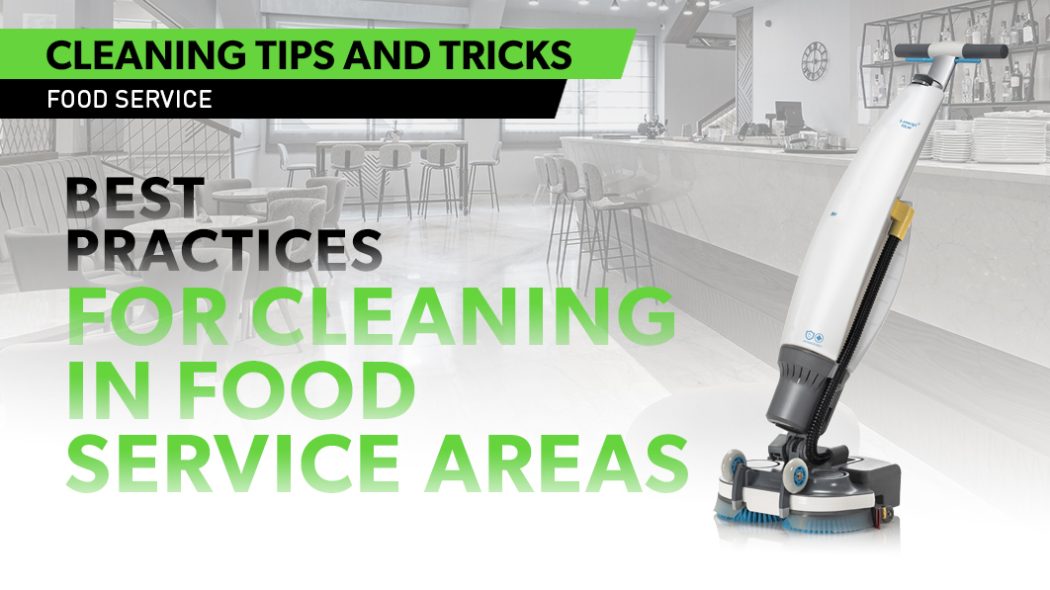
.
Estimated reading time: 6 minutes
.
Cleaning is a high priority in food prep areas like quick-serve restaurants (QSRs), school cafeterias and the like. The risk of food-borne illness from cross-contamination and shoddy cleaning practices is simply too high. According to foodsafety.gov1, food poisoning sends 128,000 Americans to the hospital each year and can cause long-term health problems.
.
This statistic is likely on the minds of employees who prepare food in spaces like QSRs and school cafeterias. But keeping these smaller food prep areas clean can be challenging with multiple staff working elbow-to-elbow to make food and serve customers or students.
.
While frequently washing hands, utensils and surfaces is the standard, the floors of food prep areas may not seem like a high priority. But they should be. Soiled food prep floors can lead to health and sanitation issues as well as dangerous slip-and-fall accidents.
.
According to the National Floor Safety Institute (NFSI)2, more than three million food service employees in America are injured annually from slips, trips and falls. And the leading cause of slip-and-fall accidents in the food service industry is wet, greasy, soiled floors.
.
Drop the mop and bucket
.
The traditional mop-and-bucket approach to cleaning is typically the go-to in tight, smaller spaces like food prep areas. But like many conventional practices, they evolve. While mops have advanced slightly over the years, there hasn’t been enough innovation to overcome the primary problem with conventional mops—they just move dirt around, not lift it. This is less than ideal for school floor cleaning and restaurant floor cleaning in food prep areas.
.
Plus, if the mop is sitting in dirty water all day waiting for a second or third use, you’re just going to apply dirty water to a dirty floor. In addition, an often reused mop head can be contaminated with bacteria, dirt and grime, which means those contaminants are being applied to the floor—not removed. Finally, you need to be precise about the ratio of water and chemicals. If too much chemical is added to the bucket water, you can have chemical residue and buildup that can damage hard floors.
.
What should be used to clean floors in food service areas
.
The mechanized mop has transformed cleaning in small, tight spaces and displaced the conventional mop-and-bucket approach to floor cleaning. It’s ideal for smaller food prep areas that need to maintain cleaning standards but can’t accommodate or afford larger cleaning equipment.
.
The mechanized mop, micro-scrubbers, and other small, mobile automatic scrubbers have become more affordable and faster to implement—and more cost-effective
.
Modern, mechanized mops provide many advantages for smaller food prep areas in QSRs, school cafeterias, etc. They improve cleaning performance by more effectively cleaning and shining floors. They boost efficiency by enabling faster floor cleaning and cleaning tight spaces with ease and consistency. They can also lead to greater staff satisfaction—reducing the physical burden on staff and giving them more time for other responsibilities.
.
Importantly, mechanized mops, floor scrubbers, and other small space cleaning equipment can reduce slip-and-fall risks and staff safety risks associated with lifting and moving heavy mop buckets. There’s also a public health benefits as mechanized mops clean more effectively and reduce cross-contamination risks of dirty mop water.
.
The IPC family of Compact Floor Scrubbers
.
IPC’s walk-behind compact scrubbers allow organizations of all sizes to finally drop the dirty, traditional mop and step up to a better, more efficient and sustainable clean.
.
The i-mop floor scrubber features simple and intuitive controls that operators can learn in minutes, a lightweight design for low-effort maneuverability, detachable tanks for quick dumps and fills, and advanced, no-maintenance lithium-ion batteries to maximize run time and minimize disruptions.
.
The IPC floor scrubber portfolio consists of:
.
i-mop Lite—the smallest, lightest model in the portfolio that provides the cleaning performance of a mechanized scrubber with the mobility of a flat mop. It’s lightweight design and high maneuverability makes it ideal for cleaning tight spaces and around obstacles.
.
CT5—equipped with an 11 inch brush and foldable handle, the CT5 is ideal for smaller spaces where scrubbers were unable to reach before.
.
CT15—ideal for cleaning under tables in food service areas and getting a deep clean in kitchens, the compact power of CT15 with lithium-ion is exceptional in restaurants and schools.
.
Modern food prep calls for modern cleaning
.
Cleaning and maintaining floors in smaller food prep areas is subject to the same scrutiny as larger commercial kitchens. You must abide by health regulations as well as look out for the health of those who will consume the food you prepare. It’s no small task, but smaller, modernized cleaning equipment can help you clean quickly and efficiently, with physical less exertion—while maintaining consistently high standards of clean.
.
Read more about a better alternative to a mop for cleaning small spaces.
.
Contact us for solutions to clean your floor prep area.
.
References
1 BSCAI, Contractor Connections, Cleaning Coalition of America Launches Survey Results Regarding Cleanliness in the Workplace, https://www.bscai.org/Contractor-Connections-Hub/Full-Article/cleaning-coalition-of-america-launches-survey-results-regarding-cleanliness-in-the-workplace, January 5, 2022
2 Research and Markets, Contract Cleaning Services Industry Outlook, 2022-2026 – Developed Regions Lead, Developing Economies to Spearhead Future Growth, https://www.globenewswire.com/en/news-release/2022/03/15/2403261/28124/en/Contract-Cleaning-Services-Industry-Outlook-2022-2026-Developed-Regions-Lead-Developing-Economies-to-Spearhead-Future-Growth.html, March 15, 2022